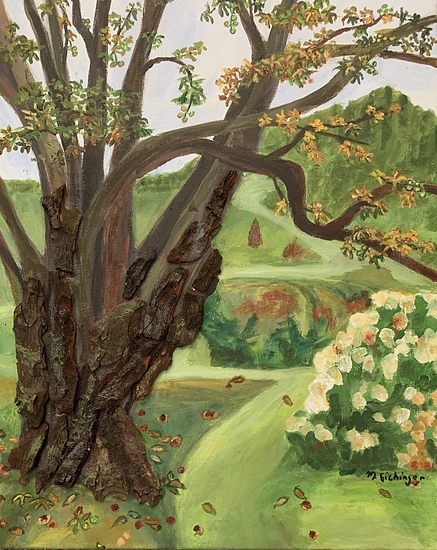
Chestnut trees are known to live 800 years. Imagine the changes that occur while they spread their limbs during the fourth industrial revolution.
The Fourth Industrial Revolution
COVID-19 is a wake-up call, a shout-out for resilience. The pandemic created a vacuum that opened space for possibility. Though the illness is horrific, it let us see changes that have been occurring over the past several decades. It pointed out problems but also showed us what happens when society is thrust into a new era. We left the industrial and computer ages behind years ago and are moving to a world where advances in artificial intelligence and biotechnology will lead the way. The period we are in is spoken of as the fourth industrial revolution.
Now able to visit distant friends virtually instead of boarding a plane, within ten to twenty years we will be able to communicate with friends who leave earth to reside on the moon. With 3D printers, machines that can show emotions, bionic body parts, and genetically designed health care, the old ways are gone forever. In order to prepare for change, shine light from the past through a prism and watch it emerge as a rainbow of possibilities on other side.
COVID, our prism, illuminated empathy and the importance of science. It focused on dangerous antics of uneducated middle-class men while showing us people suffering in a land of plenty. Sequestering forced us to grapple with loneliness and learn to live in the moment, holding off plans for a future we don’t fully understand.
With pictures of the nation’s economic and political divide brought into living rooms, we saw the plight of the poor and how people of color and native populations are treated. We learned that poverty is interconnected with health care, unemployment and lack of affordable housing. And, in the midst of multiple traumas we realized how important it is to share in community and yet reserve time for ourselves.
The pandemic also demonstrated that good government matters and that leaders who carried the welfare of their countrymen and women in their hearts, mitigated effects of the illness.Their examples taught us that the way we interact with neighbors matters. But for citizens to follow directives by government leaders, they must be transparent, trustworthy, and accountable.
Nations practicing multilateralism experienced synergistic benefits from working together. The European Union, for example, became stronger while facing COVID, migration, and climate change challenges. International participation in youth rallies, the women’s movement, and Black Lives Matter marches demonstrated what is possible when like minded people build platforms for resilience and fight against seemingly impossible odds.
The pandemic is already spurring discussions on how to make systemic improvements to the way business and government operates. I am more hopeful now than I was a year ago. There are times when things have to hit rock bottom before they get better. When that happens, there is a lot to do.
China, the largest emitter of greenhouse gasses, has done an about face by instituting policies that shift their economy toward a low-carbon future. When the United States dropped out of the Paris Accord, they assumed a leadership position in greening the world through carbon neutral investments in foreign infrastructures. Though our federal government is not involved, thankfully, individual states and companies are committed to lowering carbon emissions, with the hope of slowing global warming.
The projected surge in migrations caused by drought, flooding, and unlivable conditions has to be faced head on. Climate displacement has already caused entire communities to leave their ancestor’s bones behind on islands and coastal areas. Western Alaskans are forced to abandon their villages due to melting glaciers and erosion. We need to make plans to accommodate and help migrants resettle rather than treat them as pariahs.
But there are signs of progress as well. During the next fifty years, developments in artificial intelligence and biotechnology will explode. Have you noticed the shift in attention given to mind than rather than body activities? Fantasy sports and gaming, for instance, attract more people than ever attended live sporting events. A man like Steven Hawking could not have survived to contributed so well without advances in healthcare and AI. Symbols rather than the written word are used by youth who communicate with emojis and computer short hand. My son sent “<3” as an expression of love and best wishes. I had no idea what he meant.
Change in energy and materials technology already influence the way buildings are constructed and transportation systems designed. From airplane windows we see solar panels and gardens on rooftops. City planners of costal cities are reimagining how to coexist with rising waters with some suggesting we direct the sea through town in canals like the Dutch do in Amsterdam.
Corporate capitalism is bending to public pressure by incorporating social responsibility into its mode of operating. 200 Chief executive officers, including Amazon’s Jeff Bezos, Apple’s Tim Cook, and General Motors’ Mary Barra, signed an agreement to move away from “shareholder primacy,” to include all stakeholders such as employees, suppliers, and consumers. By doing good, they expect to have a positive impact on global economies which in turn will be good for business.
No one knows for sure how this Fourth Revolution will fully evolve, except that the way our lives are conducted is bound to be different. COBOTS, robots designed to interact physically with humans in collaborative environments and augmented reality and virtual reality are bringing enriched immersive experiences. Big data will allow massive data management and interpretation for business purposes and 3D and 4D printing will give us a way to quickly, accurately, and economically develop prototypes and products for sale.
My advice in how to cope with change is try to understand the past but not overly dwell on it. Rather, look to the future with curiosity and flexibility. Change can be exciting if you are a part of it. To prepare children, immerse them in STEAM education and teach them to be empathetic, creative, and competent problem solvers.
References:
Sandalow, D. (2019) Guide to Chinese Climate Policy 2019. COLUMBIA/ SIPA Center on global Energy Policy. PDF retrieved from https://energypolicy.columbia.edu/sites/default/files/file-uploads/Guide%20to%20Chinese%20Climate%20Policy_2019.pdf
Ball, J ( 2020The climate of Chinese checks: Easing global warming by greening Chinese foreign infrastructure investment. Brookings. retrieved from https://www.brookings.edu/articles/the-climate-of-chinese-checks-easing-global-warming-by-greening-chinese-foreign-infrastructure-investment/
Web site (2019) Climate Change Forcing Some Alaskan Villages to Relocate. Insurance Journal. www.insurancegournal.com/news/west/2019/06/20/530000.htm
Web site (2020) Moon to Mars Overview, NASA. retrieved from https://www.nasa.gov/topics/moon-to-mars/overview
Walsh, B. (2020) A coming bio revolution is poised to change the world. AXIOS> retrieved from https://www.axios.com/biotech-revolution-covid19-coronavirus-world-14a98277-e9c2-4f01-8419-986377d0e96b.html
Pranavathiyani,G (2017) Revolution of Artificial Intelligence in Science. Towards Data Science. retrieved from https://towardsdatascience.com/revolution-of-artificial-intelligence-in-science-4047440a3cd0
Cevora, G. (2019) The relationship between Biological and Artificial Intelligence. Towards Data Science. retrieved from https://towardsdatascience.com/the-relationship-between-biological-and-artificial-intelligence-aeaf5fb93e19
Gelles, D & Yaffe-Bellany,D. (2019) Shareholder Value is No Longer Everything, Top C.E.O.s Say. New York Times. Retrieved from https://www.nytimes.com/2019/08/19/business/business-roundtable-ceos-corporations.html
Newsletter (2020) Industry 4.0:Which technologies will mark the Fourth Industrial Revolution. IBERDROL. retrieved from FOURTH REVOLUTION https://www.iberdrola.com/innovation/fourth-industrial-revolution#:~:text=The%20concept%20of%20the%20Fourth,book%20of%20the%20same%20name.
Art is always for sale. Chestnut Trees is an acrylic on canvas with tree bark imbedded in the painting/ 20″ x16″ x2″ / $325. Call for to make arrangements. marilynne@eichingerfineart.com.
___________________________________________

Available online and in bookstores in paperback and ebook formats.
Save the date: November 17th at 7pm.
ZOOM book talk sponsored by Lake Oswego Library, Lake Oswego, Oregon.
